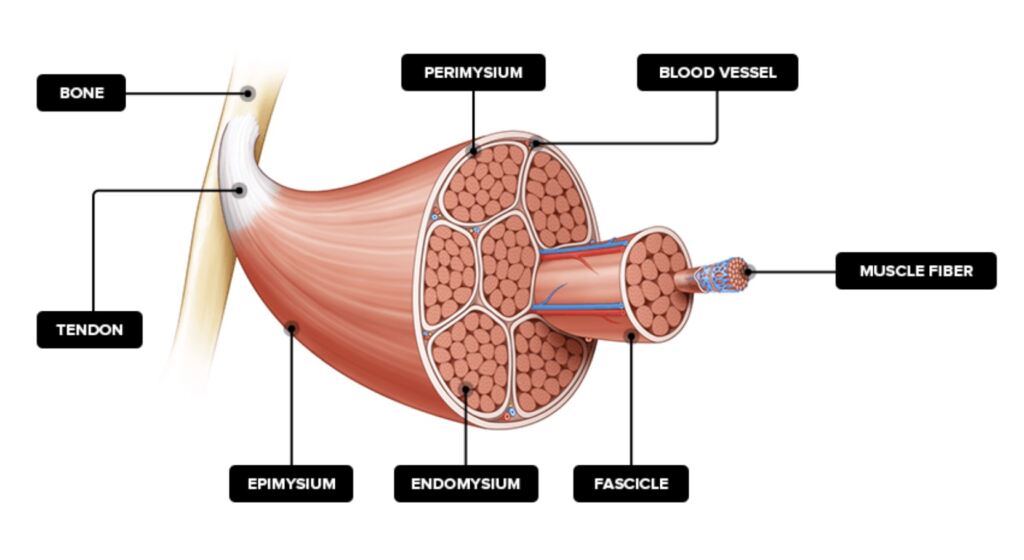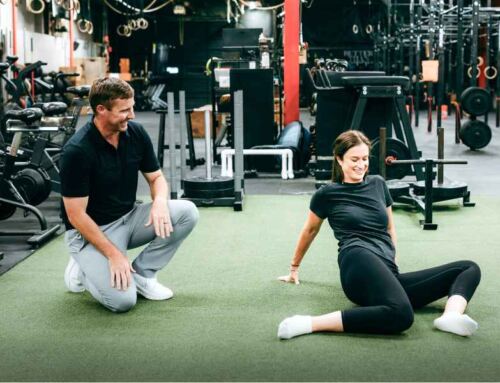Blood flow restriction, or BFR, is a technique used with exercise to strengthen muscle tissues using lower load exercises. In order to use BFR we need a pneumatic device that acts as a tourniquet. This will be placed on the most proximal, or highest, portion of the target limb. It should be placed above the target muscle group(s). The device, or cuff, will be inflated to an occlusion pressure that is specific to the individual. They will then perform a low intensity resistance exercise with the cuff on. The individual will perform high repetitions of the exercise with a short rest.
Why Use Blood Flow Restriction?
BFR can mimic the effects of high intensity exercise. By occluding the blood flow, the cuffs create a hypoxic environment. When we strength train, the activation of muscles creates compression of local blood vessels, resulting in less oxygen being delivered to the muscle. With less oxygen, there is an accumulation of metabolites such as lactic acid that build up and lead to an anabolic reaction. This is a chemical reaction that builds more complex molecules from simpler ones using energy. This results in hypertrophy, or the building up in size of muscle tissue.

Image by Michael Matthews via https://legionathletics.com/what-is-muscle-hypertrophy/
When BFR Might Be a Good Idea (Indications)
Blood flow restriction training can be a valuable tool for individuals looking to enhance muscle growth and strength under specific conditions. It’s particularly beneficial in scenarios where traditional high-load resistance training is not feasible, such as during post-surgical rehabilitation or for those dealing with pain or load limitations. By creating a hypoxic environment in the target muscles, BFR enables significant gains in muscle mass and cardiovascular capacity with lower intensity exercises, making it an effective option for improving physical performance while minimizing strain.
Here are some situations where BFR might be effective:
- Muscle weakness or atrophy, whether after an injury or surgery
- To improve muscle mass
- To improve VO2 max
- Individuals that are “load compromised” – i.e. they have restrictions in how much load they can lift after surgery
- Pain is a limiting factor in progressing exercise dosage
When BFR Might Be a Bad Idea (Contraindications)
While BFR can be highly effective, it’s not suitable for everyone. Individuals with certain medical conditions or risk factors should avoid BFR training due to potential complications. Conditions such as a history of deep vein thrombosis, cardiovascular issues, or active infections pose significant risks. Similarly, precautions should be taken in cases of numbness, subcutaneous hemorrhage, or other sensitivities. Understanding these contraindications is essential to ensure BFR is used safely and effectively within its intended scope.
Here are some situations where BFR may be ineffective or dangerous:
- History of deep-vein thrombosis or stroke
- Pregnancy
- Peripheral vascular conditions (like varicose veins)
- High Blood pressure
- Cardiac Disease
- Rhabdomyolysis
- Active infections
- Lymphadenectomy
- Cancer or tumor
- Extremity with dialysis access
- Acidosis
- Open fracture
- Increased intracranial pressure
- Vascular grafts
- Medications known to increase clotting risk
Precautions include:
- Subcutaneous hemorrhage
- Numbness
- DOMS
- “Feeling Cold”
How to Incorporate BFR into a PT Session
In order to use BFR cuffs, we need to know the individual’s occlusion pressure, or the pressure it takes to completely stop the blood flow to a limb.
Many of the cuffs on the market today automatically assess this pressure. Once we know our occlusion pressure, we can adjust the cuff to occlude to 60%.
The individual then will perform low intensity resistance exercises with the following rep scheme: 30 reps, 15 reps, 15 reps, 15 reps. Between each set, the individual will rest for 30 seconds. After the set, the cuffs can be deflated for 2 minutes before moving to the next exercise where this rep scheme will be repeated.
I personally love to use the BFR cuffs with individuals who have knee pain secondary to weakness of the quads. This can be someone dealing with patellar tendinopathy, patellofemoral pain syndrome, or post-operative ACL repair, just to name a few conditions. These individuals may present with high irritability or pain in their knee preventing them from loading their quads enough to make notable changes in their strength. The BFR will allow them to perform a lower load exercise, but still see the results of a higher intensity exercise that may traditionally exacerbate their symptoms.

Image from CISM Physical Therapy via https://www.cismpt.com/blood-flow-restriction
Sample Session of BFR
This sample session assumes 60% occlusion pressure in the BFR cuff.
Exercise 1: Spanish Squats
Take 30 seconds rest between each set.
Set 1: 30 reps
Set 2: 15 reps
Set 3: 15 reps
Set 4: 15 reps
Deflate cuff and take 2 minutes rest
Exercise 2: Hamstring Bridge
Take 30 seconds rest between each set.
Set 1: 30 reps
Set 2: 15 reps
Set 3: 15 reps
Set 4: 15 reps
References
- Barraclough, Dan. Image of a patient performing knee extension with blood flow restriction cuffs. June 2020. CISM Physical Therapy, https://www.cismpt.com/blood-flow-restriction. Accessed 12 Dec. 2024.
- “Blood Flow Restriction Training.” Physiopedia, . 6 Jun 2024, 17:32 UTC. 11 Dec 2024, 22:12 <https://www.physio-pedia.com/index.php?title=Blood_Flow_Restriction_Training&oldid=355058>.
- Das A, Paton B. Is There a Minimum Effective Dose for Vascular Occlusion During Blood Flow Restriction Training? Front Physiol. 2022 Apr 8;13:838115. doi: 10.3389/fphys.2022.838115. PMID: 35464074; PMCID: PMC9024204.
- Matthews, Michael. Structure of a Skeletal Muscle. 2024. Legion, https://legionathletics.com/what-is-muscle-hypertrophy/. Accessed 11 Dec. 2024.
- Urrutia, Dalton. “Blood Flow Restriction Training in a Nutshell – the Prehab Guys.” [P]Rehab, The Prehab Guys LLC, 13 Dec. 2022, theprehabguys.com/blood-flow-restriction-training-in-a-nutshell/
About the Author
Dr. Cali Pyzdrowski is a physical therapist in the Spring Lake, North Carolina area. She specializes in working with CrossFit athletes and is a Coach and Competitor herself. Among Cali Pyzdrowski’s treatment specialties are orthopedic pain and injuries, and sports injuries. No matter your age or movement styles, Dr. Cali is here to help you move well so you can live better.








